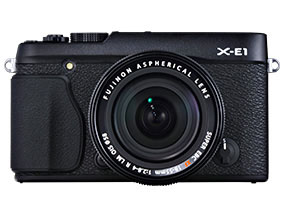
Last month I picked up a Fujifilm X-E1 and several Fujinon lenses for certain types of shooting where I need great image quality in small, light, portable equipment. This camera is a “rangefinder style” (though not literally a rangefinder) camera with an electronic viewfinder, and it evokes memories of classic rangefinder cameras by way of its small size, its overall design, and the relatively small lenses that it uses. I have had a chance to use it enough now to understand how it works and how well, and I’m very impressed with the camera and even more impressed with the Fujinon lenses and the image quality they can produce on this camera. Recently I posted a report on my initial experiences (“Fujifilm X-E1: From DSLR to Mirrorless“) and I will likely add a real review at some point.
In any case, I would like to share links to several of the Fujifilm cameras in this category, along with links to some of the Fujinon lenses, most of which I have now used. (The links go to site-sponsor B&H Photo.)
Bodies
- X-E1 – interchangeable lenses, electronic viewfinder (this is the one I own)
- Fujifilm X-E1 Digital Camera (Black) – body only)
- Fujifilm X-E1 Digital Camera (Silver) – (body only)
- Fujifilm X-E1 Digital Camera Kit (Black) – (kit with 18-55mm lens)
- Fujifilm X-E1 Digital Camera Kit (Silver) – (kit with 18-55mm lens)
- Other Related Bodies
- Fujifilm X PRO – (body only – functionally very similar to the X-E1 but with an optical viewfinder option)
- Fujifilm X100S Digital Camera – (digital rangefinder with fixed focal length non-interchangeable lens)
- Fujifilm X20 Digital Camera (Black) – (mirrorless body with fixed zoom lens)
- Fujifilm X20 Digital Camera (Silver) – (mirrorless body with fixed zoom lens)
Lenses
- Fujifilm 35mm f/1.4 XF R Lens *
- Fujifilm 18mm f/2.0 XF R Lens
- Fujifilm 60mm f/2.4 XF Macro Lens *
- Fujifilm XF 14mm f/2.8 R Ultra Wide-Angle Lens *
- Fujifilm XF 18-55mm f/2.8-4 R LM OIS Zoom Lens *
- Fujifilm XF 55-200mm f/3.5-4.8 R LM OIS Lens **
* I have used these lenses and am very impressed by their quality.
** The 55-200mm zoom has been announced but is not yet available. I intend to acquire it when it is available.
© Copyright 2013 G Dan Mitchell – all rights reserved.
 G Dan Mitchell is a California photographer and visual opportunist whose subjects include the Pacific coast, redwood forests, central California oak/grasslands, the Sierra Nevada, California deserts, urban landscapes, night photography, and more.
G Dan Mitchell is a California photographer and visual opportunist whose subjects include the Pacific coast, redwood forests, central California oak/grasslands, the Sierra Nevada, California deserts, urban landscapes, night photography, and more.
Blog | About | Flickr | Twitter | Facebook | Google+ | 500px.com | LinkedIn | Email
Text, photographs, and other media are © Copyright G Dan Mitchell (or others when indicated) and are not in the public domain and may not be used on websites, blogs, or in other media without advance permission from G Dan Mitchell.
